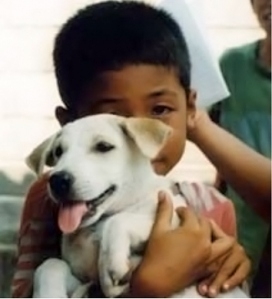The Thai Rikki-Tikki-Tavi

We all know Rikki-Tikki-Tavi, the brave mongoose from Kipling’s ‘The Jungle book’. This is the story of Mah Noy, the brave dog from Koh Lanta Yai in Southern Thai.
Koh Lanta Yai (เกาะลันตา) is still a well-kept secret of Thailand (I shouldn’t even reveal the name). Relatively close to the much more known Koh Phuket and Koh Pi Pi, but virtually inaccessible unless you want to take two flights, a long drive, and sail twice, this South Andaman island is definitely not overrun by tourists and almost devoid of western influence except for a few resorts for those who want a taste of unspoiled paradise. Koh Lanta Yai is the biggest of 52 islands of which only 12 are inhabited.
Of course for me it’s much easier to get to Koh Lanta, being resident in a neighboring island only 43.5 nautical miles away. The beaches are great and unsullied, the water clear and warm (about 86-88 F), the undersea world along the coral reef just breathtaking, although fortunately not literally. I always look forward to one more diving assignment there, drifting above the Staghorn and the Anemone corals monitoring the various species’ fortunes. What a great job!
When I’m working there, I go ashore in the evening and find a modest accommodation right up the beach. One of those days just before sunset, I’m sitting in front of my bungalow, cleaning and washing my equipment, when two children come along to talk to me, as always, curious about foreigners. I had seen them before; they belong to the food booth where I use to eat, just behind the bungalow. We talk about the sea and the fish and about my diving gear, which of course fascinates them. After finishing readying the gear, I decide to walk the 30 yards up the cliff to grab something to eat, and the kids follow me. My Thai is not as good as I wished, but the good thing about it is that since it is so difficult to pronounce the words correctly, I always commit embarrassing mistakes producing a great deal of giggling—and giggling is the best way I know to decrease distance between strangers.
‘Khun cheu arai?’ (What’s your name?), I ask the most giggling of the two boys, the one missing the front teeth. He tells me his name, which sounds funny to me. I know that Thais have all kind of nicknames and they are especially fond of animal names. Elephant, shrimp, crab, fish, bird, duck, rabbit, turtle, and even chicken are common names—but I’ve never heard anyone named as the little boy. It’s then, that his mother, Poo (Crab), the owner of the food booth, tells me the story.
Five years earlier, two days after giving birth to the now toothless boy, Poo was cooking dinner while their dog was catnapping behind the cradle where the newborn baby was happily babbling.
Thais usually cook outdoors. It’s always warm and they don’t like the smell of food indoors. The dog was typical Thai, of unknown origin, the size of a small spaniel, with an unruly black and white coat, and friendly deep brown eyes. They had found him on the streets a couple of years before and had fed him. Lacking a better name, they called him just (หมาน้อย), Mah Noy. He stayed around and finally moved in a couple of weeks later after conquering their hearts. The pressure of natural selection for dogs in Thailand is on kindness. The kindest dogs have a greater chance to survive and give their ‘kinder-genes’ to their progeny.
That particular day, Mah Noy gave Poo a serious scare so that she almost lost her hot pan and could have burned her self seriously. The dog rumbled once, a deep growl, and in two agile and determined jumps, barely missing the baby’s cradle, he was on top of a cobra with its teeth deeply planted behind the cobra’s head.
The Andaman Cobra (Naja sagittifera) is an impressing snake, about three to four feet long. The effects of its venom are devastating, capable of killing a human in 30 minutes.
Poo was terrified, hastened to pick up the baby, and out of the front gate she ran to the street, shouting for her husband to come. When Na (short for Chai Cha Na = victory) got home, he ran to the backyard grabbing a spade. The cobra was lying a few feet from the dog, apparently lifeless, but Na, just in case, cut it in two with a well-aimed strike with the spade. Mah Noy looked at him once, grasping for air, and barely wagged the tip of his bushy tail. Na understood right away that the dog was dying, picked him up, and holding his dog firmly on his lap with one hand, he drove his motorbike as quickly as he could to the local vet.
On the way to the vet, Mah Noy peed and pooped on his lap. Na stopped to get a better grasp on the dog. Mah Noy looked at him, grasped for air a last time and gave him a final wagging. Na understood that he was too late for the vet and it was then that this strong fisherman from the South Andaman sea wept like a child, right there on the berm of the road to Klong Dao, in the fading light on yet a glorious day on these shores where he had been so close to loosing his first born baby boy.
When Na got home to Poo and their newborn, they buried Mah Noy in their backyard and they placed a yellow marigold (yellow is the color of friendship for Thais) on top of the grave. That evening, they decided to call their baby boy หมาน้อย, Mah Noy, which in Thai means ‘puppy’.
Sawasdee khrap,
ชีวิต ที่ด
R—
You can also read this story at http://wp.me/p1J7GF-g8.




